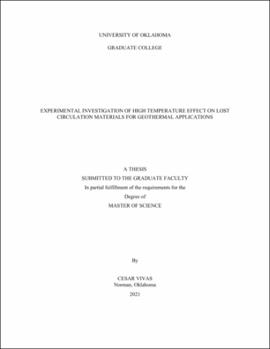| dc.description.abstract | Sustainable energy generation is crucial to meet the energy demands in the 21st century while keeping the implications of future challenges at its core philosophy. A geothermal power generation plant is one of such avenues that meet the associated challenges by utilizing the thermal energy stored in the earth to generate clean power. The energy acquired in the process, termed as geothermal energy, has the highest baseload due to its independence of seasonal factors (e.g., sunlight, winds, cloudiness). Despite the vast potential of geothermal energy, factors such as operational risks during drilling continue to limit its widespread development.
The geothermal drilling is impacted by a high-pressure and high-temperature (HPHT) environment at the subsurface. The high temperatures (HT) and the corrosive environment of geothermal drilling make the design of the drilling fluid a very complicated task. The HT geothermal drilling leads to major concerns, including thermal degradation. The drilling fluid thermal degradation impacts drilling processes such as the cuttings evacuation, hole cleaning, filtration, and fluid loss performance. These issues can lead to major operational problems such as massive mud losses, stuck pipe events, or poor cementing jobs if not adequately addressed.
Additionally, geothermal fields are characterized by the presence of highly fractured rocks. The combination of corrosive environment and fractured rock generates the need to incorporate additives for alkalinity, fluid loss control, and lost circulation. Research to analyze the effect of the additive’s thermal degradation on the drilling fluid rheological properties in temperatures near or above 300°F (149°C) is limited. Thus, an extensive laboratory study is performed on water-based mud (WBM) drilling fluids.
Laboratory tests were performed using an HPHT rheometer to measure drilling fluid properties up to 400°F (204.5°C). Rheological properties, density, filtration, lost circulation, and alkalinity control additives at HT were measured during this work. Three different alkalinity control materials (Caustic Soda, Potassium Hydroxide (KOH), and Lime) were evaluated. Lime presented the best thermal stability at 400°F with an average variation of 2.4 cp (0.0024 pa.s) on apparent viscosity after three consecutive tests. Moreover, this alkalinity control material (lime) presented the least volume of mud gelled (2%) at HT. In contrast, Caustic Soda showed the highest volume of mud gelled (58%), adversely affecting mud rheology.
Additionally, twelve (12) different lost circulation materials (LCM) were tested for understanding their rheological behavior at HT. The study showed that HT has less impact on fine granular materials rheological behavior with an average increase of 17.7% compared with the baseline. In contrast, flaky, fibrous, and coarse granular materials presented an undesirable increase in rheology. The average rheology of the latter was 166% compared with the baseline.
The second stage of the experimental study consisted of performing laboratory investigation of LCM at HT. Eleven (11) different materials were tested; Walnut Fine, Walnut Medium, Sawdust, Altavert, Graphite Blend, Bentonite Chips, Micronized Cellulose (MICRO-C), Magma Fiber Fine, diatomaceous earth/amorphous silica powder (DEASP), Cotton Seed Hulls, and a Calcium Carbonate Blend. The filtration and sealing pressure of the LCMs were measured with HPHT equipment up to 300°F (149°C). Furthermore, the particle size distribution (PSD) of granular materials was measured. The results show that some LCM materials commonly used in geothermal operations are more sensitive to degrade at HT. Characteristics such as shape and size made some materials more prone to thermal degradation. Also, it was found that the PSD of LCMs is a key factor in bridging and sealing fractures. The results suggest that granular materials with a wide particle size distribution PSD are more suitable for geothermal applications. | en_US |
